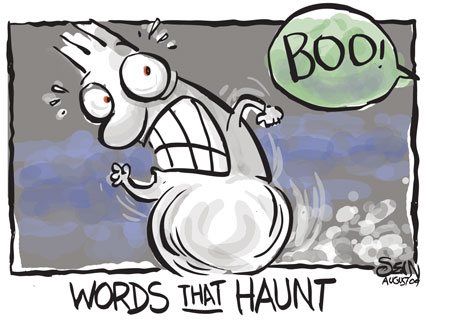
Let's say you're writing an article. And let's also assume that you're writing a pretty good article when suddenly you manage to slip in a ‘throwaway line'.
So what's a throwaway line?
A throwaway line is a line that's often not related to the article. It's probably just a thought that popped up in your head at that moment, and so you just dropped it in. You didn't think that a single line would disrupt the entire process of the article, would you? And yet it does.
So let's take an example
Let's say the article is about ‘How to speak well in front of a video camera'. And there you are writing away about how to speak well, when you say something like:
“Public speaking has never bothered you. So why are you so camera shy?”
Now see what you did there? It was a throwaway line.
And you know that it's a throwaway, because when you read your completed article you notice that you didn't mention public speaking at all in the rest of the article. And yet it's probably created a disruption in your article that you just don't need.
And here's how the disruption plays itself out…
If you ask around you'll find that people are quite shy of public speaking. They'll do it, but doesn't mean it hasn't bothered them. For instance, my wife Renuka has given dozens of presentations, but it still sends her into a tizzy getting ready. You could wake me from my sleep and ask me to give a presentation, and I'd do it. But not Renuka.
So when Renuka reads that throwaway line, she freezes.
Now she can't focus on the article, because there's a burr in her head. That burr/obstruction causes her brain to bring up all the emotions of being ‘bothered' by public speaking. And so once that 'emotional dam' breaks, you've lost Renuka. And therefore lost the control over the reader.
Notice that if you just remove that throwaway line, there's no emotional dam breaking. And so the reader stays with you.
Throwaway lines are dangerous.
We put them in articles.
We put them in videos.
We put them in speaking.
Even as we say them, we realise that ‘Ugh, I shouldn't have said that.'
And yes there's a way to sharpen your article and reduce throwaway lines. When writing an article, don't just write an article. Think of a person who it would apply to. e.g. When I was writing about discounts, I thought about a marketer who is my friend and is always discounting. When I wrote this article, I thought of a client called Perry.
So I'm rarely just writing an article. I'm thinking of how youÑthe readerÑwill react to the article.
And so you have to decide who you're writing to.
You may have been writing to me, and hey the line “Public speaking has never bothered you” would be just fine. But if you're not speaking to meÑand it's more than likely that you're notÑthen you need to keep the person in mind.
That's the first step to reducing throwaway lines, but hey, there's a second step.
The second method is read your article again, and you'll discover that you've made random comments that have little or no bearing on the article. All you have to do is simply remove those random comments, and your article will flow nicely once again.
So let's summarise:
1) Throwaway lines are lines you think of on the spur of the moment.
2) You'll include a throwaway line and forget about it, but the customer gets distracted.
3) This distraction could be a minor distraction, or an emotional dam of sorts.
4) If it's an emotional dam, you've completely lost the customer over a single line.
5) The best way to avoid throwaway lines is to write with someone specific in mind.
6) Writing for someone specific will make you think of that person in greater detail.
7) Of course the other way to reduce throwaway lines is to read your article and ruthlessly edit any unnecessary lines.
This ability to avoid throwaway lines in your article writing isn't always easy. This is because you get one thought, and then the next thought slips in, and you want to put both the thoughts on paper. And it's perfectly fine to put those thoughts down.
But when you're done with the article, and you're giving it a quick scan through, see if there are any throwaway lines in the article. Lines that may have relevance to the topic, but are still just a distraction. And once you remove those lines, your article will flow smoothly once again.
More Goodies: Find the entire series on article-writing (articles not tips) in text and audio with cartoons!

Why do you insert an N with a ~ above it between certain words in your text ? l find these quite distracting when reading.
I think that Ñ is an em dash. And somehow wherever the em dash has to appear, it’s inserted a Ñ. Sorry about that. I’ll fix it later. And thanks.
YES! The term you use for those “pop-up phrases” is so *IT*… I call them “nags”. I know they don’t belong in the article, but they nag me until I write them somewhere.
I get those all the time and I’ve learned over the years not to discard them totally. I actually collect them in a separate list. Those *throwaways* usually become topics for future articles.
I figure that if my own brain is sending me those *nags*, it’s either because it’s a question that needs answering or it’s the answer to a question that’s been asked to me before.
We hate to police our creativity, but sometimes it needs to be scolded into submission. My mantra is now to carve out the superfluous. Thanx.